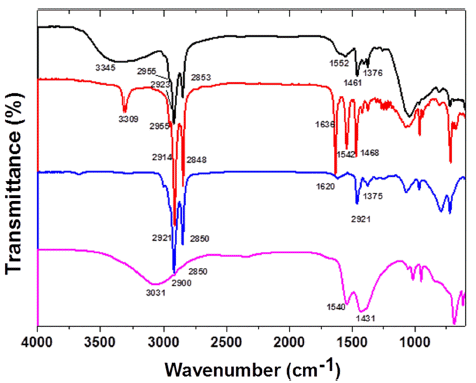- [Korean]
- Synthesis of Hexagonal Boron Nitride Nanocrystals and Their Application to Thermally Conductive Composites
-
Jae-Yong Jung, Yang-Do Kim, Pyung-Woo Shin, Young-Kuk Kim
-
J Korean Powder Metall Inst. 2016;23(6):414-419. Published online December 1, 2016
-
DOI: https://doi.org/10.4150/KPMI.2016.23.6.414
-
-
 Abstract Abstract
 PDF PDF
Much attention has been paid to thermally conductive materials for efficient heat dissipation of electronic devices to maintain their functionality and to support lifetime span. Hexagonal boron nitride (h-BN), which has a high thermal conductivity, is one of the most suitable materials for thermally conductive composites. In this study, we synthesize h-BN nanocrystals by pyrolysis of cost-effective precursors, boric acid, and melamine. Through pyrolysis at 900°C and subsequent annealing at 1500°C, h-BN nanoparticles with diameters of ~80 nm are synthesized. We demonstrate that the addition of small amounts of Eu-containing salts during the preparation of melamine borate precursors significantly enhanced the crystallinity of h-BN. In particular, addition of Eu assists the growth of h-BN nanoplatelets with diameters up to ~200 nm. Polymer composites containing both spherical Al2O3 (70 vol%) and Eu-doped h-BN nanoparticles (4 vol%) show an enhanced thermal conductivity (λ ~ 1.72W/mK), which is larger than the thermal conductivity of polymer composites containing spherical Al2O3 (70 vol%) as the sole fillers (λ ~ 1.48W/mK).
- [Korean]
- Improved Luminescent Characterization and Synthesis of InP/ZnS Quantum Dot with High-Stability Precursor
-
Eun-Jin Lee, Jong-Woo Moon, Yang-Do Kim, Pyung-Woo Shin, Young-Kuk Kim
-
J Korean Powder Metall Inst. 2015;22(6):385-390. Published online December 1, 2015
-
DOI: https://doi.org/10.4150/KPMI.2015.22.6.385
-
-
625
View
-
3
Download
-
2
Citations
-
 Abstract Abstract
 PDF PDF
We report a synthesis of non-toxic InP nanocrystals using non-pyrolytic precursors instead of pyrolytic and unstable tris(trimethylsilyl)phosphine, a popular precursor for synthesis of InP nanocrystals. In this study, InP nanocrystals are successfully synthesized using hexaethyl phosphorous triamide (HPT) and the synthesized InP nanocrystals showed a broad and weak photoluminescence (PL) spectrum. As synthesized InP nanocrystals are subjected to further surface modification process to enhance their stability and photoluminescence. Surface modification of InP nanocrystals is done at 230°C using 1-dodecanethiol, zinc acetate and fatty acid as sources of ZnS shell. After surface modification, the synthesized InP/ZnS nanocrystals show intense PL spectra centered at the emission wavelength 612 nm through 633 nm. The synthesized InP/ZnS core/shell structure is confirmed with X-ray diffraction (XRD) and Inductively Coupled Plasma - Atomic Emission Spectrometer (ICP-AES). After surface modification, InP/ZnS nanocrystals having narrow particle size distribution are observed by Field Emission Transmission Electron Microscope (FE-TEM). In contrast to uncapped InP nanocrystals, InP/ZnS nanocrystals treated with a newly developed surface modified procedure show highly enhanced PL spectra with quantum yield of 47%. -
Citations
Citations to this article as recorded by  - Synthesis and luminescence characteristics of manganese-doped ZnSe quantum dots synthesized in aqueous solution through internal doping
Hyun Seon Hong, Yerin Kim, Jea Hyung Kim, Hyeon Seon Ryu, Dahye Song
Journal of the Korean Ceramic Society.2025; 62(3): 472. CrossRef - Synthesis and Properties of InP/ZnS core/shell Nanoparticles with One-pot process
So Yeong Joo, Myung Hwan Hong, Leeseung Kang, Tae Hyung Kim, Chan Gi Lee
Journal of Korean Powder Metallurgy Institute.2017; 24(1): 11. CrossRef
- [Korean]
- Synthesis of Highly Dispersible Metal Nanoparticles in P3HT:PCBM Layers and Their Effects on the Performance of Polymer Solar Cells
-
Min-Ji Kim, Gyu-Chae Choi, Young-Kuk Kim, Yang-Do Kim, Youn-Kyoung Baek
-
J Korean Powder Metall Inst. 2014;21(3):179-184. Published online June 1, 2014
-
DOI: https://doi.org/10.4150/KPMI.2014.21.3.179
-
-
 Abstract Abstract
 PDF PDF
In this study, we prepare polymer solar cells incorporating organic ligand-modified Ag nanoparticles (OAgNPs) highly dispersed in the P3HT:PCBM layer. Ag nanoparticles decorated with water-dispersible ligands (WAgNPs) were also utilized as a control sample. The existence of the ligands on the Ag surface was confirmed by FTIR spectra. Metal nanoparticles with different surface chemistries exhibited different dispersion tendencies. O-AgNPs were highly dispersed even at high concentrations, whereas W-AgNPs exhibited significant aggregation in the polymer layer. Both dispersion and blending concentration of the Ag nanoparticles in P3HT:PCBM matrix had critical effects on the device performance as well as light absorption. The significant changes in short-circuit current density (JSC) of the solar cells seemed to be related to the change in the polymer morphology according to the concentration of AgNPs introduced. These findings suggested the importance of uniform dispersion of plasmonic metal nanoparticles and their blending concentration conditions in order to boost the solar cell performance.
- [Korean]
- Formation of CdSe Hollow Sphere by In-Situ-Template-Interface Reaction (ISTIR) Method
-
Moon-Hee Choi, Yoon-Bok Lee, Hyong-Kuk Kim, Young-Mok Rhyim, Jin-Chun Kim, Young-Seok Kim, Yang-Do Kim
-
J Korean Powder Metall Inst. 2005;12(4):291-295.
-
DOI: https://doi.org/10.4150/KPMI.2005.12.4.291
-
-
 Abstract Abstract
 PDF PDF
- CdSe hollow sphere with average size of about 30-50 nm was synthesized from the mixed solution of cadmium chloride (CdCl_2), sodium selenosulfate (Na_2SeSO_3) and ethylenediamine(EDA, H_2NCH_2CH_2NH_2) at room temperature. The molar ratio of EDA to Cd2+ showed the most significant effect on the morphology of CdSe hollow sphere. This paper will present and discuss the possible formation mechanism of CdSe hollow sphere based on the observation of morphological changes.
|







